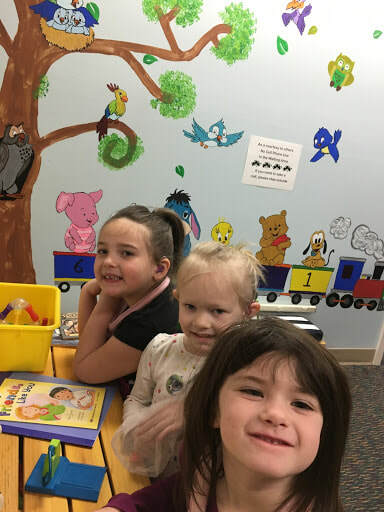Audiology / Hearing Center
The Hearing Center provides diagnostic hearing evaluations by licensed audiologists for children in Berrien and Cass County from birth through graduation. Children may be referred by their parent/guardian as well as other sources such as school personnel, physicians, Health Department or local hospitals for follow up newborn hearing screenings. Early identification of permanent hearing loss and intervention is our primary focus. The number one indicator for childhood hearing loss is parental concern.
Educational audiologists are part of the the school multidisciplinary team who facilitate listening, learning and communication access through specialized assessments, monitor personal hearing instruments, recommend, fit and manage hearing assistance technology, provide and recommend support services, and advocate for the student. They also collaborate with the private sector audiologists to facilitate students learning and access to sound.
School is an auditory world and students with hearing loss need technology to access it. The Hearing Center provides FM equipment and other assistive technologies for students to use in the classroom. In our world of ever changing technology, ensuring deaf/hard of hearing students have access to information it critical.
Once an educationally significant hearing loss has been identified, our job is to help coordinate and initiate audiological and educational services for the student. We work with families to obtain access to personal hearing aids, cochlear implant evaluations, medical consultation, educational services, and FM systems as the child’s needs dictate. The Hearing Center has a bank of loaner hearing aids available to children while families complete the process of financial support for purchasing their own hearing aids so there is not a delay in access to sound for the deaf/hard of hearing child.
Newborn Hearing Screening
The Michigan Department of Health Early Hearing Detection and Intervention (EHDI) program recommends that newborn hearing screening be completed by one month of age, diagnosis of permanent hearing loss by 3 months of age, and early intervention (educational) services begin by 6 months of age.
With early identification and appropriate services, deaf and hard of hearing children can develop communication skills at the same rate as their hearing peers.
- We hear with our brains, not our ears.
- It takes 20,000 hours of listening before a child's brain is ready to learn to read.
- Listening = Learning
- Consistent listening experiences in early childhood (birth thru age 3) are very important for the development of speech, language and listening.
- 25%-35% of children with unilateral hearing loss are at risk for failing at least one grade level.
- Students with unaided hearing loss earned on average $20,000 less than those who use hearing aids or cochlear implants.
Related Stats
- Approximately 3 million children in the U.S. have a hearing loss; 1.3 million of them are under the age of three.
- Babies are never too young to have their hearing tested.
- 15% of children between the ages of 6-19 have a measurable hearing loss in at least one ear.
- Hearing loss occurs in 5 out of every 1,000 newborns.
- Over 90% of deaf children are born to hearing parents.
- A mild hearing loss can cause a child to miss as much as 50% of classroom discussion.
FM and Hearing Assistance Technology (HAT)
Benefits of hearing assistance technology (HAT) in the classroom:
- There is an improved “signal to noise” ratio - the systems make it easier to hear the person(teacher) talking over all of the background noise that happens in a classroom setting.
- Personal FM systems reduce the distance sound has to travel to get to the deaf/hard of hearing students’ ears.
- FM systems make it easier to hear what the student is supposed to hear over all of the noise they are not.
- The microphone in the FM system can be shared with other people/students in class to ensure all information is shared. The microphone can also be used as a table microphone for the increasing group work that is a part of students’ day.
- HAT is also critical for standardized testing to ensure deaf/hard of hearing students have the same access to test materials/settings.
Most Common Questions
What is a Cochlear Implant:
- A cochlear implant is a surgically implanted neuroprosthetic device that provides a sense of sound to a person with a severe to profound hearing loss. They bypass the damaged portion of the ear and directly stimulate the auditory nerve.
- A child may qualify for a cochlear implant if they do not achieve one year of speech and language growth within one calendar year with consistent hearing technology use.
- Most children will obtain better spoken language development with the use of a cochlear implant with hearing thresholds of 80dB HL or poorer.
Hearing Aid FAQ:
- How many hours a day should my child wear hearing aids? - The phrase if your Eyes are open then your ears are on says it all. All waking hours is the recommendation. Hearing technology should be taken out for sleep, bath and swimming.
- How long should my child’s hearing aids last? - Hearing aids last 4-5 years unless a change in hearing requires a change in technology.
- How do I care for my child’s hearing aids? - A listening stethoset is used by the family to complete daily listening checks to ensure technology is working properly. It is also recommended that a Dry-aid storage kit be used at night to dehumidify the hearing aids.
- Why is there feedback/squealing from the hearing aids? - This can happen if there is a cerumen (ear wax) build up in the ear canals or when the earmolds are not fully inserted or have become too small
-
 Click to see a larger version
Skip to end of gallery
Skip to start of gallery
Click to see a larger version
Skip to end of gallery
Skip to start of gallery
-
 Click to see a larger version
Skip to end of gallery
Skip to start of gallery
Click to see a larger version
Skip to end of gallery
Skip to start of gallery
-
 Click to see a larger version
Skip to end of gallery
Skip to start of gallery
Click to see a larger version
Skip to end of gallery
Skip to start of gallery
-
 Click to see a larger version
Skip to end of gallery
Skip to start of gallery
Click to see a larger version
Skip to end of gallery
Skip to start of gallery
Contact Us
To contact our office, please call, email or text. The information is below.
Ashley Porter
Coordinator of ECSE and D/HH Programs
Ashley Hicks
Secretary
Phone: (269) 471-8858
Email: ahicks@homeoftheshamrocks.org
Fax: (269) 471-8866
Text: (269) 921-9732





